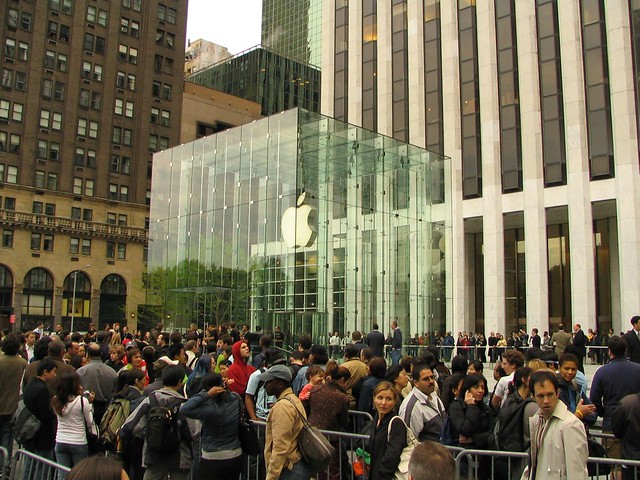The Apple Store is coming, and Grand Central may never be the same. That, at least, is a dramatic take on the latest news.
Later today, the MTA Finance Committee will vote to approve a 10-year lease with Apple for the current Metrazur space, and after months of rumors, the computer and tech giant will begin preparation for the space. It is, for Apple, an ambitious undertaking. At 23,000 square feet, the Grand Central store will be the company’s largest, and Apple was the only company to respond to the MTA’s RFP for the space. They — and not the MTA — will pay Metrazur $5 million to terminate their lease early and have vowed to make only “modest alterations” to historic elements while keeping signage at a minimum. Still, the store’s presence will be felt.
First, the lease terms: Apple will be renting out the entire northern balcony for payments that start at $800,000 a year and grow to over $1 million by year ten. They will also be renting an additional amount of ancillary facilities for over $300,000 a year, growing to $400,000 by year ten. The lease contains two five-year options as well. In addition to the Metrazur space, the currently-closed northeast balcony will be a part of Apple’s retail store as well.
In its own materials, the MTA feels it is getting an above-market offer from Apple even though they were the only ones to respond to the RFP. They are paying significantly more than Metrazur does now. Apple has said that construction will last approximately 120 days once they obtain control over the property. So it seems as though opening in time for the 2011 holiday season would be optimistic at best.
What intrigues me most about Apple’s arrival is its sheer popularity. The MTA isn’t charging a sales percentage on the lease, but the authority anticipates that the presence of the Apple Store will boost gross sales to its other Grand Central terminal by at least 1 percent which would add $500,000 to the MTA’s take. The dollars, though, are the least of my concerns.
The staff summary of the lease has a sentence that piqued my curiosity. “Recognizing that the Apple Store is expected to attract many customers and entail a substantial back-of-house operation, Apple Metro-North and MTA Police Department personnel have engaged in intensive planning effort to ensure that Apple’s operations will be compatible in all respect, and not interfere with, the primary use of the terminal as a transportation facility.”
In other words, keep those long lines out of the way of harried commuters.
Even as Grand Central matures into a retail and food hub, it is as its most basic level a place that services people going somewhere else. It’s home to one of the busiest subway stations in the city as well as the largest number of train platforms in the world. Turning it into a destination has increased its popularity and made it a more pleasant place to wait for trains, but it still must get people to their destinations.
So Apple will have to compromise. When the iPad 2 came out in March, I checked out the line on 14th St., and it went from the corner of 14th and 9th Ave. to 17th and 10th Ave. That won’t work in Grand Central as commuters try to navigate gadget-crazed fans. Apple has vowed to make it work, and so has the MTA. In a few months, we’ll see it in action.


















 While the news of
While the news of  Jay Walder has tendered his resignation as MTA CEO and Chair, effective October 21, 2011, the MTA announced this afternoon. Walder, who has served as head of the MTA since October 2009 and has led a remarkable effort to trim internal costs and improve the authority’s bureaucracy, will be joining the joining the MTR Corporation — a publicly-traded company based in Hong Kong that operates rail services in Asia and Europe — as Chief Executive Officer and a member of the Board of Directors.
Jay Walder has tendered his resignation as MTA CEO and Chair, effective October 21, 2011, the MTA announced this afternoon. Walder, who has served as head of the MTA since October 2009 and has led a remarkable effort to trim internal costs and improve the authority’s bureaucracy, will be joining the joining the MTR Corporation — a publicly-traded company based in Hong Kong that operates rail services in Asia and Europe — as Chief Executive Officer and a member of the Board of Directors. 

 The MTA has launched its push for capital funding today with a report that pledges an additional $2 billion in cuts to its current five-year plan. With Albany gearing up to assess the immediate future of New York City’s public transit system and its short-term capital future, the MTA is out to prove that it can spend money efficiently and wisely while acknowledging that cuts to the funding grant are necessary to move forward.
The MTA has launched its push for capital funding today with a report that pledges an additional $2 billion in cuts to its current five-year plan. With Albany gearing up to assess the immediate future of New York City’s public transit system and its short-term capital future, the MTA is out to prove that it can spend money efficiently and wisely while acknowledging that cuts to the funding grant are necessary to move forward.